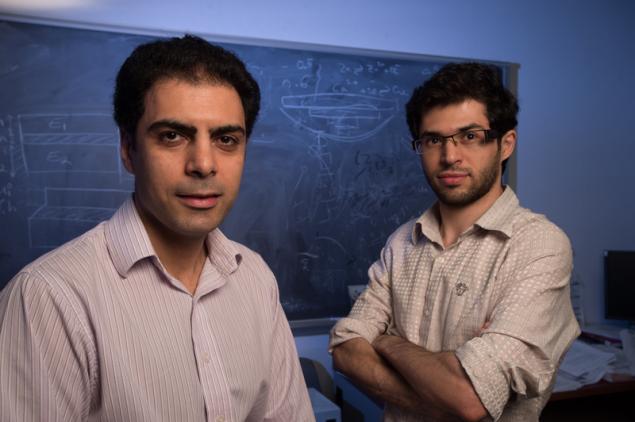370
Scientists have modeled effective 3D nanostructures
Researchers from rice University, using computer simulation, saw the advantages of 3D boron nitride.
According to the engineers, three-dimensional porous nanostructure has the necessary balance of strength, stiffness and ability to transfer heat, which allows you to use it for nanoelectronics, gas storage and composite materials manufacturing.
Scientists have created 3D prototypes of one-dimensional nanotubes of boron nitride and two-dimensional sheets of the material. Study co-author Rouzbeh Shahsavari says: "We combined the tubes and sheets together to make a material three-dimensional, thus offering more functionality. 3-D nanostructure is very thin sheets of boron nitride are stacked in parallel layers, and the tubular shape are placed between them to separate".

The resulting structure has more effective properties. So, if one-dimensional nanotubes can be stretched by 20 percent of its length, the 3-D prototype of boron nitride can be stretched up to 45 percent, not damaged. In addition, when a one-or two-dimensional materials are stretched in one direction, they have a tendency to shrinkage in the other perpendicular directions. In the 3-D prototype this does not happen. Shahsavari says: "At the junction between the tubes and the leaves have a unique curve known as auxetic effect."
Also increase the heating properties of new boron nitride. A one-dimensional tube and two-dimensional sheets can carry heat in one or two directions. 3-D prototype carries heat relatively fast in all directions. Shahsavari says: "This feature is ideal for applications that require materials or coating with the possibility of very fast diffusion in the environment. For example, car engines or computer CPUs where a fast heat transfer is crucial for the operation".
To all the other advantages, 3-D boron nitride has a very porous and lightweight structure. Each gram of this new material has the surface area equivalent to three tennis courts. It provides efficient storage and separation of gas, for example, in vehicles operating on hydrogen.
In contrast to graphene nanostructures, boron nitride is an electrically insulating material. Because of this, it has the potential for nanoelectronics, including for the next generation of 3-D semiconductors and 3-D thermal transport devices, which could be used in nanoscale calorimeters, microelectronic processors, macroscopic refrigerators.
Although 3-D boron nitride has yet to be created in the laboratory, scientists are confident, "our computer simulations show what properties can be expected from these structures and what are the key factors controlling their functionality."
Source: nauka24news.ru/
According to the engineers, three-dimensional porous nanostructure has the necessary balance of strength, stiffness and ability to transfer heat, which allows you to use it for nanoelectronics, gas storage and composite materials manufacturing.
Scientists have created 3D prototypes of one-dimensional nanotubes of boron nitride and two-dimensional sheets of the material. Study co-author Rouzbeh Shahsavari says: "We combined the tubes and sheets together to make a material three-dimensional, thus offering more functionality. 3-D nanostructure is very thin sheets of boron nitride are stacked in parallel layers, and the tubular shape are placed between them to separate".

The resulting structure has more effective properties. So, if one-dimensional nanotubes can be stretched by 20 percent of its length, the 3-D prototype of boron nitride can be stretched up to 45 percent, not damaged. In addition, when a one-or two-dimensional materials are stretched in one direction, they have a tendency to shrinkage in the other perpendicular directions. In the 3-D prototype this does not happen. Shahsavari says: "At the junction between the tubes and the leaves have a unique curve known as auxetic effect."
Also increase the heating properties of new boron nitride. A one-dimensional tube and two-dimensional sheets can carry heat in one or two directions. 3-D prototype carries heat relatively fast in all directions. Shahsavari says: "This feature is ideal for applications that require materials or coating with the possibility of very fast diffusion in the environment. For example, car engines or computer CPUs where a fast heat transfer is crucial for the operation".
To all the other advantages, 3-D boron nitride has a very porous and lightweight structure. Each gram of this new material has the surface area equivalent to three tennis courts. It provides efficient storage and separation of gas, for example, in vehicles operating on hydrogen.
In contrast to graphene nanostructures, boron nitride is an electrically insulating material. Because of this, it has the potential for nanoelectronics, including for the next generation of 3-D semiconductors and 3-D thermal transport devices, which could be used in nanoscale calorimeters, microelectronic processors, macroscopic refrigerators.
Although 3-D boron nitride has yet to be created in the laboratory, scientists are confident, "our computer simulations show what properties can be expected from these structures and what are the key factors controlling their functionality."
Source: nauka24news.ru/























